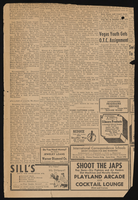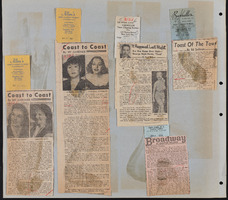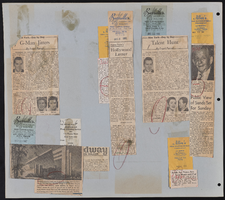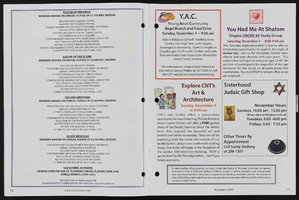Search the Special Collections and Archives Portal
Search Results
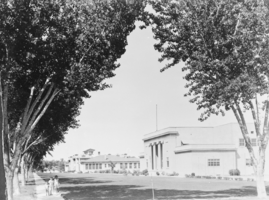
Film transparency of the Las Vegas Grammar School and Las Vegas High School, Las Vegas, Nevada, 1931
Date
1931
Archival Collection
Description
Center: the Las Vegas Grammar School, built in 1911, and demolished between 1964-1965; Right: the Las Vegas High School, built in 1917, was burned May 11, 1934. The photo was taken in 1931.
Image
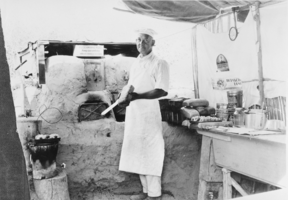
Film transparency of Sergeant Clyatt, in his bake shop at the landing on the Arizona River near Ragtown near Boulder City, Nevada, circa 1930s
Date
1930 to 1939
Archival Collection
Description
Sergeant Clyatt, in his bake shop at the landing on the Arizona River near Ragtown near Boulder City, Nevada. He established a relief station there and served bread and coffee to families left homeless after a brush fire at the river. Photo was taken circa 1930s. (NOTE: Photos of Elton Garrett, family, and friends transferred to B.C. - D. McBride collection)
Image
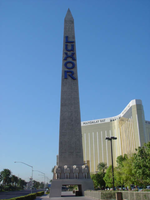
Photographs of Luxor signs, Las Vegas (Nev.), 2002
Date
2002
2017-08-15
Archival Collection
Description
Photos show Luxor signs during the day. Two surveys were conducted to gather information about this sign. One was conducted in 2002 and one was conducted in 2017. PDFs are available for both surveys. See the 2017 survey PDF for additional information that is not included in the object description.
Site name: Luxor (Las Vegas, Nev.)
Site address: 3900 S Las Vegas Blvd
Sign owner: Mandalay Resort Group
Sign details: The giant black, glass, pyramid rises out of the desert as certainly one of the most unique structures. The pyramid is also accompanied by a monolithic, heavily geometric structure, finished in the same black, panels of windows. Just to the north. The front of the property is dominated by an array or Egyptian architectural landmarks such as an giant obelisk, the Sphinx, various statues of Egyptian gods and pharaohs line the multi tiered expanse of concrete and stucco. The property is pedestrian interactive, being able to pass underneath the giant obelisk, and through and beneath the giant Sphinx. The feel produced by area is appropriate for the desert environment.
Sign condition: Structure 5 Surface 5 Lighting 5
Sign form: Pylon; Fascia; Porte-cochère
Sign-specific description: On the expanse of concrete in front of Las Vegas Blvd, just north of the obelisk, a double-sided pylon sign joins the ancient composition. The pylon actually is more akin to the pylons seen at properties such as the Monte Carlo or the Mirage. It is located in the northern portion of the property on the west side of the strip-facing northwest along Las Vegas Blvd Two square posts support a two-sided square cabinet which houses a back lit advertisement and a set of crafted letters spelling the name of the establishment. Occupying the upper portion of the space between the legs another internally lit, two sided, cabinet, atop a small pair of internally lit sculpted cabinets. From a distance the cabinets look like thumbs holding up the cabinet. The shapes are graphically treated on the surfaces to look like colorful recreations of a hieroglyphic bird, the wings being the elongated portion of the cabinet. The only art attached to the cabinet is the portion designated for the head of the creature. Three sets of sculpted cornices, create borders for the different planes. The bases of the legs are treated with the ledging, the section separating the top cabinet, from the rest of the sign, and finally another set around the top crowning edge of the sign. Both sides of the top edge have a sculpted element in the very center. A flat circle, presumably a representation of the sun, flanked by two snakes are set on a pair of large wings spreading to either side. This element is ambiently lit from underneath. The text, which spells "Luxor," is composed of polished gold channel letters, with closed faces with graphic treatments in blue upon the faces. The faces are painted to appear if the letters are faceted into three dimensions. They are lit from behind with whit neon creating a halo effect around the letters. The surface of the actual structure is finished to appear as if it is constructed of limestone, utilizing false joints and seams. The south end of the property close to the street is the four-sided obelisk. The text on the obelisk is the same word treated in the same fashion, structurally and aesthetically, as the pylon sign. The only difference is that it reads vertically from top to bottom. Statuary adorn the base of the obelisk in a repeating pattern as well as it being covered in hieroglyphic patterns. A tunnel allows for the pedestrian to pass underneath the obelisk. The porte cochere is located underneath the body of the Sphinx, another use of the architecture to incorporate the pedestrian element. If you head east through the sphinx, a tunnel opens up into a small courtyard where a shuttle bus may be caught. The ceiling of the porte cochere is adorned with a circular chandelier, composed of metal representations of leafy branches radiating around a rounded center. The ends of the arms hold length-wise half cylinder lamps. The ceiling above is painted blue. The most spectacular element of the Luxor is its super powerful light in the place of the capstone at the very peak. The beam is one of the most powerful lights in the world, and can be seen from high above into the earth's atmosphere as well. The edges of the pyramid are also raceways, which can be seen in action in the dark. An animation of bulbs makes it appear as if a single bulb of light streams up the base to the very peak. The animation runs at an interval of every couple of seconds. On the very south edge of the property, actually on the southeast corner, is a sculpted, small pylon which houses a color led screen.
Sign - type of display: Neon
Sign - media: Steel; Masonry
Sign - non-neon treatments: Plaster
Sign animation: Chasing
Sign environment: Standing next to the Mandalay Bay on the west side of the southern end of Las Vegas Blvd, the Luxor's front exterior is a sprawling mass of smooth vertical planes turning into eloquent statue and stucco walls. They are interlaced with drives and signage complete with a platform at the base of the Sphinx, which is just east of where the valet and porte cochere are grounded in the base of the beasts belly. From the edge of a Platform a tram station is located and also a view of the signage can be seen as well. The Luxor's environment is a very pedestrian one as well. Being in an isolated part of the strip, the noise clutter brought about by the surging traffic is considerably better than the heart of the strip.
Sign designer: Veldon Simpson
Sign - thematic influences: The theme of the Luxor is obviously that of ancient Egypt. The Ancient Egyptian imagery is placed among the same images but represented in the shiny black glass, giving a touch of future meets the past. The image seen are some of the most commonly seen images when talking about the Ancient Egyptian culture. The Sphinx stands guard at the base of the giant black pyramid, one sign is attached to an obelisk. Various statuary adorn the entire plaza. The environment created with the motif obviously fits into the desert like dust, but still retains the surreal nature associated with the themed hotel. The aesthetics appear to be fantastic, but are a bit odd due to the arrangements and limitations on space. It does however fir into an interesting sub category of resort that is themed around a culture. Yes it is themed around a city, but the culture shines through with more dominance. Another example of this is the Imperial Palace. It is not necessarily themed after a particular city, but the architecture and imagery suggests the Asian culture.
Surveyor: Joshua Cannaday
Survey - date completed: 2002
Sign keywords: Chasing; Pylon; Fascia; Porte-cochère; Neon; Steel; Masonry; Plaster
Site name: Luxor (Las Vegas, Nev.)
Site address: 3900 S Las Vegas Blvd
Sign owner: Mandalay Resort Group
Sign details: The giant black, glass, pyramid rises out of the desert as certainly one of the most unique structures. The pyramid is also accompanied by a monolithic, heavily geometric structure, finished in the same black, panels of windows. Just to the north. The front of the property is dominated by an array or Egyptian architectural landmarks such as an giant obelisk, the Sphinx, various statues of Egyptian gods and pharaohs line the multi tiered expanse of concrete and stucco. The property is pedestrian interactive, being able to pass underneath the giant obelisk, and through and beneath the giant Sphinx. The feel produced by area is appropriate for the desert environment.
Sign condition: Structure 5 Surface 5 Lighting 5
Sign form: Pylon; Fascia; Porte-cochère
Sign-specific description: On the expanse of concrete in front of Las Vegas Blvd, just north of the obelisk, a double-sided pylon sign joins the ancient composition. The pylon actually is more akin to the pylons seen at properties such as the Monte Carlo or the Mirage. It is located in the northern portion of the property on the west side of the strip-facing northwest along Las Vegas Blvd Two square posts support a two-sided square cabinet which houses a back lit advertisement and a set of crafted letters spelling the name of the establishment. Occupying the upper portion of the space between the legs another internally lit, two sided, cabinet, atop a small pair of internally lit sculpted cabinets. From a distance the cabinets look like thumbs holding up the cabinet. The shapes are graphically treated on the surfaces to look like colorful recreations of a hieroglyphic bird, the wings being the elongated portion of the cabinet. The only art attached to the cabinet is the portion designated for the head of the creature. Three sets of sculpted cornices, create borders for the different planes. The bases of the legs are treated with the ledging, the section separating the top cabinet, from the rest of the sign, and finally another set around the top crowning edge of the sign. Both sides of the top edge have a sculpted element in the very center. A flat circle, presumably a representation of the sun, flanked by two snakes are set on a pair of large wings spreading to either side. This element is ambiently lit from underneath. The text, which spells "Luxor," is composed of polished gold channel letters, with closed faces with graphic treatments in blue upon the faces. The faces are painted to appear if the letters are faceted into three dimensions. They are lit from behind with whit neon creating a halo effect around the letters. The surface of the actual structure is finished to appear as if it is constructed of limestone, utilizing false joints and seams. The south end of the property close to the street is the four-sided obelisk. The text on the obelisk is the same word treated in the same fashion, structurally and aesthetically, as the pylon sign. The only difference is that it reads vertically from top to bottom. Statuary adorn the base of the obelisk in a repeating pattern as well as it being covered in hieroglyphic patterns. A tunnel allows for the pedestrian to pass underneath the obelisk. The porte cochere is located underneath the body of the Sphinx, another use of the architecture to incorporate the pedestrian element. If you head east through the sphinx, a tunnel opens up into a small courtyard where a shuttle bus may be caught. The ceiling of the porte cochere is adorned with a circular chandelier, composed of metal representations of leafy branches radiating around a rounded center. The ends of the arms hold length-wise half cylinder lamps. The ceiling above is painted blue. The most spectacular element of the Luxor is its super powerful light in the place of the capstone at the very peak. The beam is one of the most powerful lights in the world, and can be seen from high above into the earth's atmosphere as well. The edges of the pyramid are also raceways, which can be seen in action in the dark. An animation of bulbs makes it appear as if a single bulb of light streams up the base to the very peak. The animation runs at an interval of every couple of seconds. On the very south edge of the property, actually on the southeast corner, is a sculpted, small pylon which houses a color led screen.
Sign - type of display: Neon
Sign - media: Steel; Masonry
Sign - non-neon treatments: Plaster
Sign animation: Chasing
Sign environment: Standing next to the Mandalay Bay on the west side of the southern end of Las Vegas Blvd, the Luxor's front exterior is a sprawling mass of smooth vertical planes turning into eloquent statue and stucco walls. They are interlaced with drives and signage complete with a platform at the base of the Sphinx, which is just east of where the valet and porte cochere are grounded in the base of the beasts belly. From the edge of a Platform a tram station is located and also a view of the signage can be seen as well. The Luxor's environment is a very pedestrian one as well. Being in an isolated part of the strip, the noise clutter brought about by the surging traffic is considerably better than the heart of the strip.
Sign designer: Veldon Simpson
Sign - thematic influences: The theme of the Luxor is obviously that of ancient Egypt. The Ancient Egyptian imagery is placed among the same images but represented in the shiny black glass, giving a touch of future meets the past. The image seen are some of the most commonly seen images when talking about the Ancient Egyptian culture. The Sphinx stands guard at the base of the giant black pyramid, one sign is attached to an obelisk. Various statuary adorn the entire plaza. The environment created with the motif obviously fits into the desert like dust, but still retains the surreal nature associated with the themed hotel. The aesthetics appear to be fantastic, but are a bit odd due to the arrangements and limitations on space. It does however fir into an interesting sub category of resort that is themed around a culture. Yes it is themed around a city, but the culture shines through with more dominance. Another example of this is the Imperial Palace. It is not necessarily themed after a particular city, but the architecture and imagery suggests the Asian culture.
Surveyor: Joshua Cannaday
Survey - date completed: 2002
Sign keywords: Chasing; Pylon; Fascia; Porte-cochère; Neon; Steel; Masonry; Plaster
Mixed Content
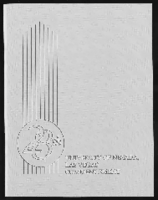
University of Nevada, Las Vegas (UNLV) 28th commencement program
Date
1991-05-19
Archival Collection
Description
Commencement program from University of Nevada, Las Vegas Commencement Programs and Graduation Lists (UA-00115).
Text
Lockette, Emory W., Sr., 1923-2005
Emory and Agnes Lockette met while they were both in college; she in Albany, Georgia, and he in Dawson, Georgia. He studied architectural and structural engineering. They secretly married in Atlanta, Georgia, in 1949 and moved to Boulder City in 1953 where they were the only African Americans during a time of tense race relations. She earned graduate degrees, including a doctorate in early childhood education, at UNLV. Initially, Mrs.
Person
Pagination
Refine my results
Content Type
Creator or Contributor
Subject
Archival Collection
Digital Project
Resource Type
Year
Material Type
Place
Language
Records Classification

